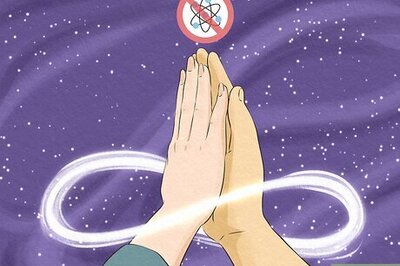
views
The word gotra was prised out of the domain of personal, and took on a political hue after Congress president Rahul Gandhi's gotra was revealed during a temple visit in Pushkar, Rajasthan.
The priest in Pushkar said that Rahul is a Dattatreya Kaul Brahmin.
Ancestry of Rahul Gandhi is subject of curiosity as his grandfather Feroze Gandhi was from the Parsi community.
What is a gotra?
In Hindu culture, the term gotra is commonly considered to be equivalent to clan. It broadly refers to people who are descendants in an unbroken male line from a common male ancestor or patrilineal. Generally, the gotra forms an exogamous unit, with the marriage within the same gotra being prohibited by custom, being regarded as incest.
The name of the gotra can be used as a surname, but it is different from a surname and is strictly maintained because of its importance in marriages among Hindus, especially among the higher castes.
According to the Brihadaranyaka Upanisad, Gautama and Bharadvāja, Viśvāmitra and Jamadagni, Vashishtha and Kaśhyapa and Shandilya were known as the seven sages (also known as saptarishi); the progeny of these seven sages are declared to be gotras. This enumeration of seven primary gotras seems to have been known to Paṇini. Paṇini defines gotra for grammatical purposes as apatyam pautraprabhrti gotram, which means “the word gotra denotes the progeny (of a sage) beginning with the son’s son.” When a person says that he is from, say, ‘Kashyapa gotra' he means that he traces his descent from the ancient sage Kashyapa by unbroken male descent.
Are the Brahmin sub-castes grouped under various gotras that are patrilineal groups?
Yes. There are major Brahmin castes in India and in addition to them, there are several Brahmin sub-castes. The Rev MA Sherring had, in the 1860s, compiled some 2,000 of them in the second volume of his Hindu Tribes and Castes. He considered the list incomplete. The Brahmin sub-castes are grouped under various gotras that are patrilineal groups. According to some Shashtras and popular belief as mentioned in “Hindu Castes and Sects” by Jogendranath Battacharya, the Brahmins in the Indian continent are divided into two major groups: Panch Gaur and Panch Dravida.
What are panch gaur and panch dravida?
The Panch Gaur are the classification of the five classes of Northern India groups that constitute Saraswata, Kanyakubja, Gaudra, Utkala, and Maithila. Under Panch Dravida there are the five classes of Southern India groups, which constitutes: Andhra, Dravida (Tamil and Kerala, Karnataka, Maharashtra, Gujarat.
The Brahmin subcastes are broadly categorised into two great geographical divisions-the north and the south. The dividing line is the Narmada River. The gaur (white) subcastes, according to Sherring, inhabit the region north of the Narmada and the dravida sub-castes, the south.
What does legend say about gotra?
According to one legend, as put by Sherring, all the chief Brahmin gotras come from the saptarishis – the seven sages.
Sherring says the Vatsa, Bida, Arshtikhena, Yaska, Mitryu, Shaunak and Bainya gotras claim descent from sage Bhrigu; the gotras of Gautam, Bharadwaj and Kewal-Angiras from sage Angirah; the Atre, Badbhutak, Garishtira and Mudhgala from sage Atri; the Kaushika, Lohit, Raukshak, Kamkayana, Aja, Katab, Dhananjya, Agamarkhan, Puran and Indrakaushika from sage Viswamitra; the Nidruba, Kasyap, Sandila, Rebha and Langakshi from sage Kasyap; the Vashisht, Kundin, Upamanyu, Parashara and Jatukaraniya from sage Vashisht; and the Idhamabahar, Somabahar, Sambhabahar and Yagyabhar from sage Agastya. Other gotras are said to have been derived from these gotras.
Are gotras identified on the basis of Vedas each one observes
Yes. Sherring listed that they are identified on the basis of the Vedas they observe. Thus the Bhargaus, Sankritas, Gargs (Chandras), Bhrigus and Saunaks follow the Rig. The Kasyaps, Kaasyaps, Vatsas, Sandilas and Dhananjays follow the Sama. The Bharadwajs, Bhaaradwajs, Angirahs, Gautams and Upamanyus observe the Yajur; and the Kaushikas, Gritakaushikas, Mudhgalas, Galawas and Vashishts follow the Atharva. All others follow the Yajur.
What is the legal situation of gotra?
While the gotras are almost universally used for determining excluding marriages that would be traditionally incestuous, they are not legally recognized as such, although those within degrees of prohibited relationship or are sapinda are not permitted to marry.
Khap panchayats in Haryana have campaigned to legally ban marriages within the same gotra.
A convener of the Kadyan Khap, Naresh Kadyan, petitioned the courts to seek amendment to the Hindu Marriage Act to legally prohibit such marriages. However, the petition was dismissed as withdrawn after being vacated, with the Delhi High Court warning that the Khap would face heavy penalty costs for wasting the time of the court.
In the 1945 court case of Madhavrao vs Raghavendrarao, which involved a Deshastha Brahmin couple, the definition of gotra as descending from eight sages and then branching out to several families was thrown out by the Bombay High Court. The court called the idea of Brahmin families descending from an unbroken line of common ancestors as indicated by the names of their respective gotras “impossible to accept.”
The court consulted relevant Hindu texts and stressed the need for Hindu society and law to keep up with the times, emphasizing that notions of good social behavior and the general ideology of the Hindu society had changed. The court also said that the mass of material in the Hindu texts is so vast and so full of contradictions that it is a near-impossible task to reduce it to order and coherence.
















Comments
0 comment